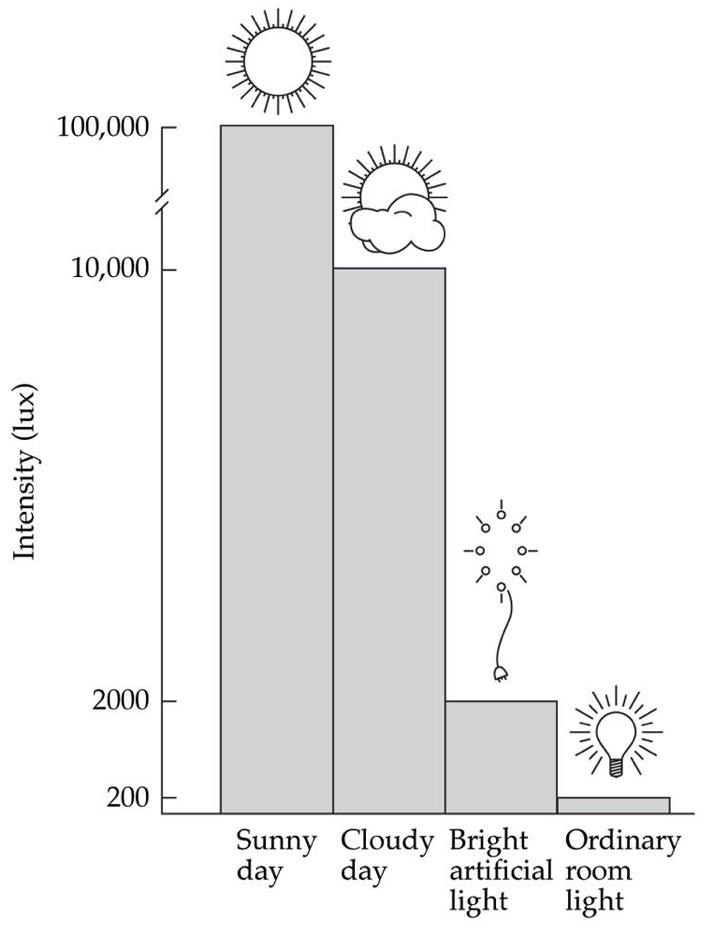Biological/Circadian Rhythms
1/27
There's no tags or description
Looks like no tags are added yet.
Name | Mastery | Learn | Test | Matching | Spaced |
|---|
No study sessions yet.
28 Terms
What is chronobiology?
Chronobiology: the study of biological clocks and associated rhythms
the timing of events within and external to an animal
The biological basis for this time-keeping in our bodies (genes, proteins, hormones)
What is a chronotype?
Early bird
getting up early, spring daylight savings (move clocks ahead by 1 hour), traveling east
Night owl
staying up late, fall daylight savings (clocks fall back by 1 hour), traveling west
Describe diurnal vs nocturnal.
Day active: diurnal
Night active: nocturnal
Animals differ dramatically with respect to rhythms in sleep/wake, wheel running, mating, and hormone sensitivity
What are different types of biological rhythms?
Ultradian: cycle is under a day (<24hr)
Circadian rhythms: cycle is about a day (24hr)
Circannual rhythms: cycle is about a year (1 year) i.e. mating seasons, migration, hibernation
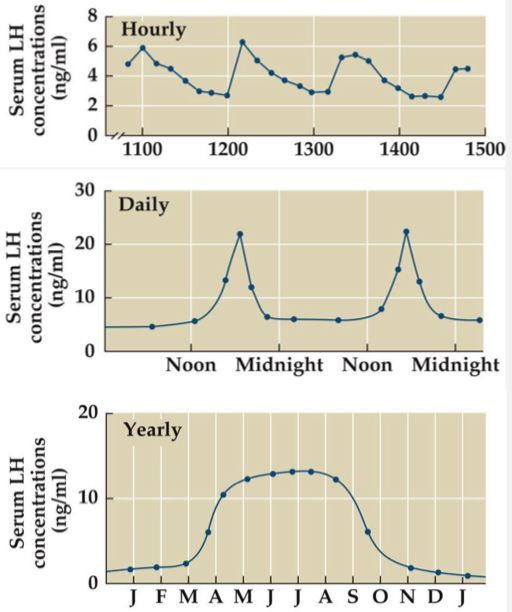
Do circadian rhythms (tau) derive from external factors, internal factors, or both?
Exogenous factors
do we become sleepy bc we’ve been awake to long or bc it’s dark?
Do rats sleep during the day bc they hate the light?
Endogenous factors
or do we become sleepy bc of something within the organism?
Biological clocks: internal timekeeping mechanisms that regulate physiological and behavioral rhythms in most living organisms
First evidence of biological rhythms in plants
heliotropic plants isolated from the sunlight, continued to open and close leaves in synchrony with the day, endogenous rhythm
Cave experiment
deprived of all environmental cues for 32 days
Tried to switch to a 28 hr day, inconclusive, irregular rhythms, arbitrary measures
How do we measure endogenous rhythms?
Movement: reliable way to keep track of wakefulness and sleep
Actogram: a log of physical activity over time
days are stacked vertically on top of one another (y-axis)
Time of day is on x-axis (24 hr)
Each day is a row
Entrainment: synchronizing an internal clock with external cue
without cues we wouldn’t reset each day, would be free-running
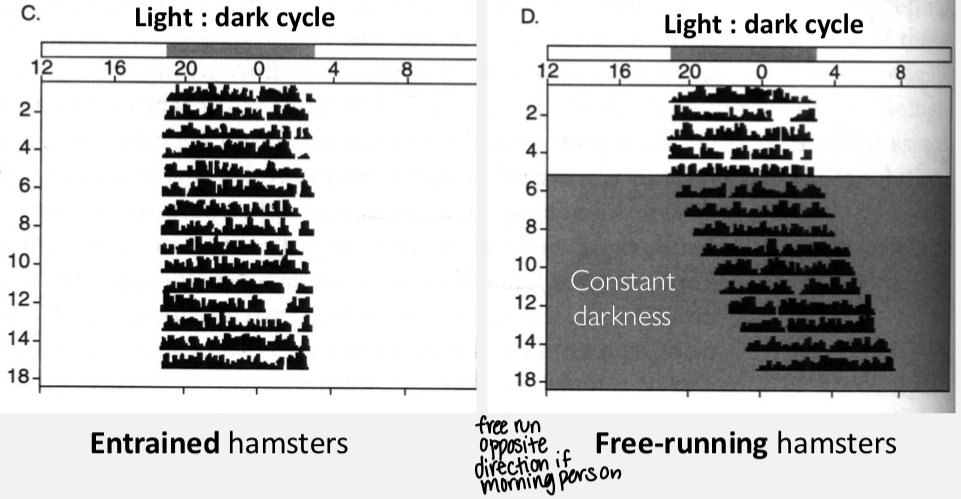
What are the components of biological rhythms?
maximum, minimum
Amplitude: amount of change above or below the average value
Period length (tau): time to complete one cycle of rhythm
Frequency (time/period): number of cycles completed in a unit of time
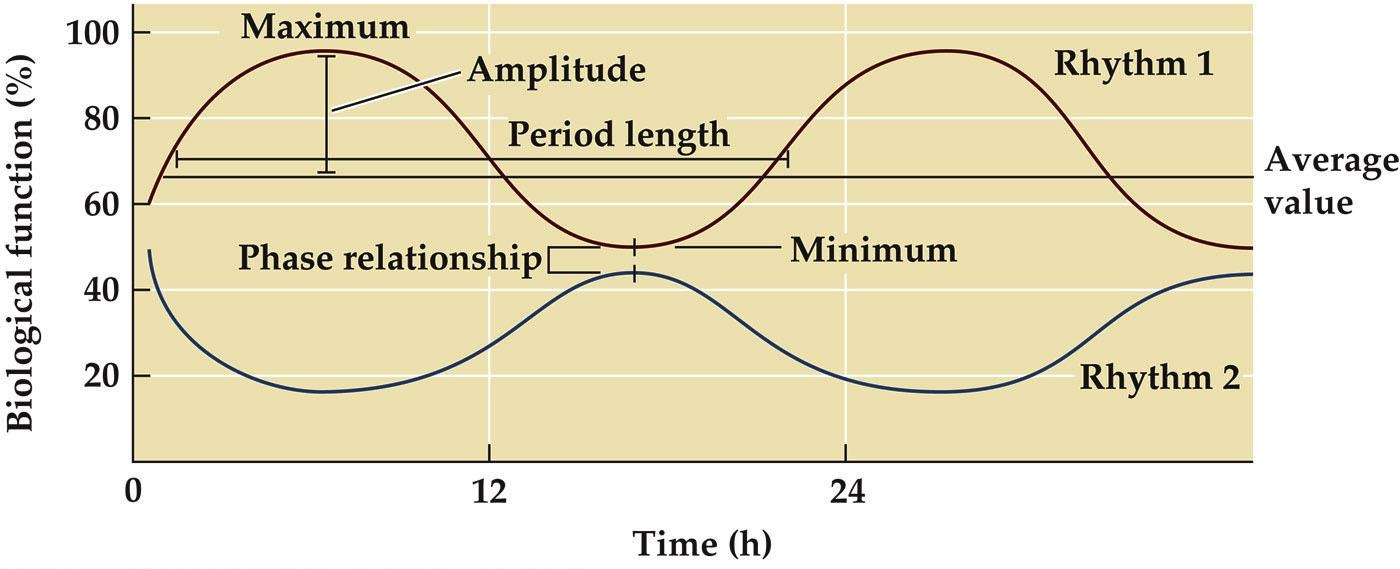
What maintains this rhythm? Where is this master clock? How do we know this is the master clock?
We have a circadian clock(s) throughout our body
The master clock is in the suprachiasmatic nuclei (SCN) of the hypothalamus
Peripheral clocks are in tissues throughout the body
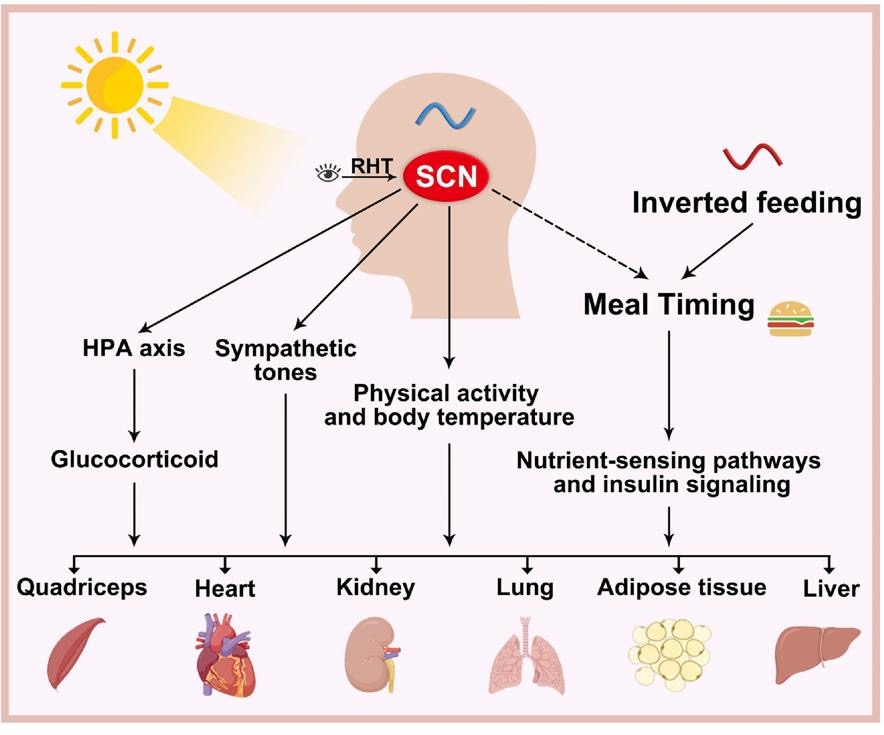
Describe the three ways we know where the master clock is.
Bilateral lesions of the SCN eliminate circadian rhythms
Neurons in slices SCN tissue continue to display circadian rhythms of electrical activity even when removed and placed in a Petri dish
Tau mutant has a short period, wild type has a regular period
if SCN tissue is transplanted into an SCN-lesioned recipient, then the period of the recipient’s rhythm will change to match that of the donor
What is a zeitgeber? What is the difference between a zeitgeber and a clock?
“time-giver”: an external cue that synchronizes an internal clock
Light is not the only zeitgeber
a women who suffered an SCN lesion during surgery showed completely erratic activity (upper actogram)
After nursing staff organized her days with scheduled bed-times, waking-times, and meals, her sleep-wake cycle started to show some daily temporal organization (lower actogram)
Exogenous zeitgebers can play an important role if endogenous rhythms are knocked out; rhythms very important for health, jobs and disorders can affect rhythms
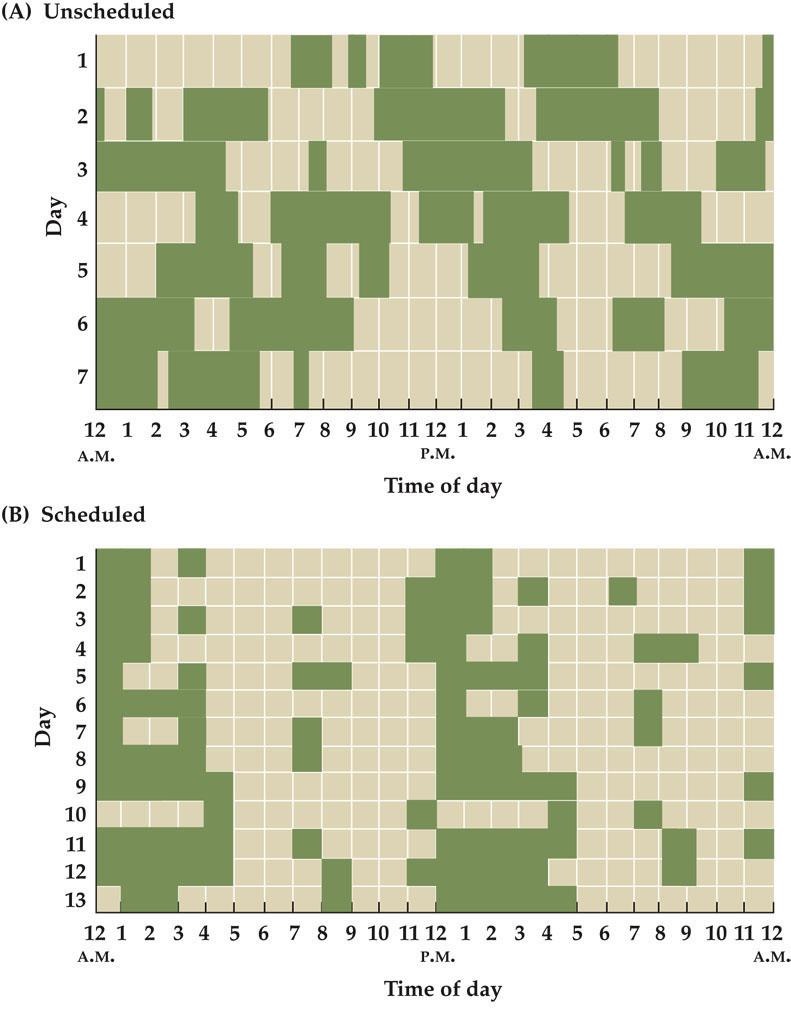
What are the characteristics of a circadian rhythm? Do all animals have them?
Cyclic: must have a period of 24hrs
Endogenous: must persist in the absence of zeitgebers (self-sustaining)
Entrainable: able to entrain to a rhythm of 24 hours in the presence of zeitgebers (like sunlight or a light pulse)
Not all animals have true circadian rhythms
reindeer living at high latitudes experience extreme photic environments, especially during the day
During the polar day and polar night, when there’s continuous light or darkness, reindeer do not consistently display 24 hr patterns of locomotor activity
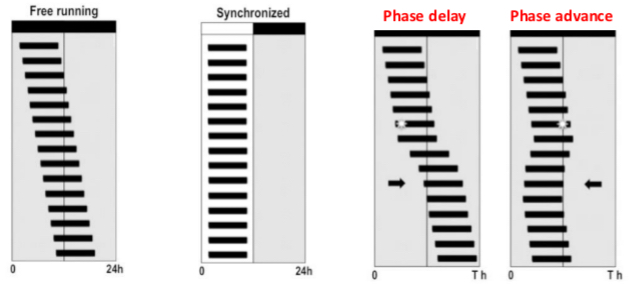
What’s the difference between SCN and zeitgebers?
SCN is what determines our endogenous rhythms (tau): this cannot be changed by external circumstances (although our endogenous rhythms can change with age or pathology)
Zeitgebers can adjust our endogenous rhythms to a new time zone or seasonal pattern of light—it doesn’t change our tau, it just phase shifts it to earlier or later
What is a phase shift? Can you identify an advance and a delay in phase shift? Can you read a phase response curve correctly?
A change in the timing of the body’s internal clock, affecting sleep-wake patterns and other biological processes
Can be a phase advance where the body clock shifts to earlier in the day
Or can be a phase delay, where it shifts to later in the day
e.g. move to California, by your clock you’re sleeping in
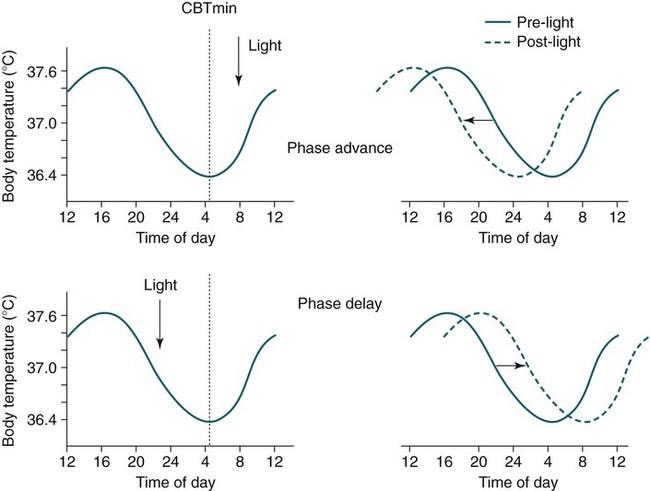
What is jet lag?
The response to a specific kind of phase shift; jet lag is not just travel fatigue
you must cross more than two time zones (2 hours) to experience jet lag
Jet lag is what occurs prior to the body making the phase shift to the light-dark cycle in the new location
Why do most people have an easier time traveling west than east?
for most people, a phase delay (traveling west) is easier than a phase advance (traveling east)
Most diurnal animals have a tau of just over 24 hours
most humans about 24 hrs and 11 min
Black lines are active phase
We like to stay up later and later, and then wake up later and later
Anomalous light later is less aversive than anomalous light earlier
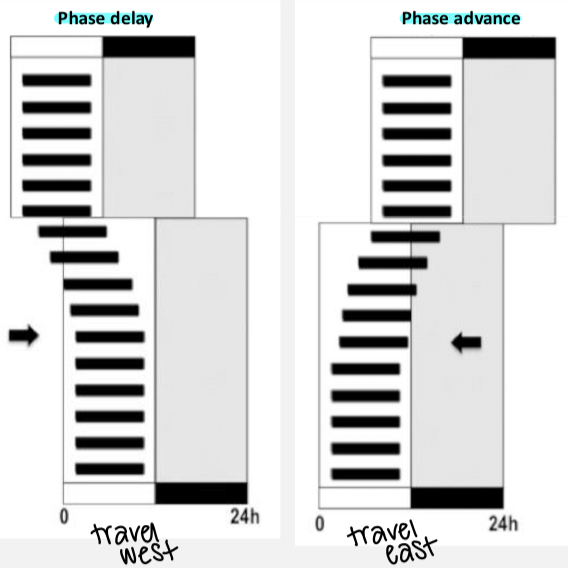
What is the phase response curve?
The relationship between the onset of a zeitgeber (e.g. a light pulse) and the effect on circadian rhythms
Treatment: light administration (blue line)
Phase shift: either a phase delay or a phase advance in hours
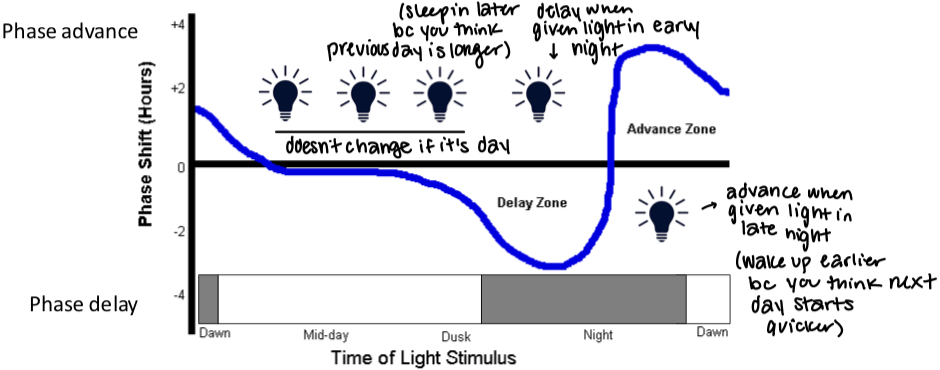
What is the role of melatonin?
Produced and secreted by the pineal gland
Light from the eye stimulates the SCN to suppress the pineal gland, darkness releases this inhibition and melatonin is produced (“darkness hormone”)
Blue light (460-480 nm) suppresses

What’s the relationship between the SCN and melatonin?
Light → retina → retinal hypothalamic tract (RHT) → suprachiasmatic nuclei (SCN) → inhibits pineal gland light→ no melatonin
Dark → SCN inactive → pineal gland begins melatonin production → further inhibits SCN

What’s the difference in melatonin between diurnal and nocturnal animals?
Strong rhythms of melatonin secretion at night in all vertebrates—doesn’t matter if diurnal or nocturnal
Melatonin alone can phase-shift locomotor activity rhythms in mice
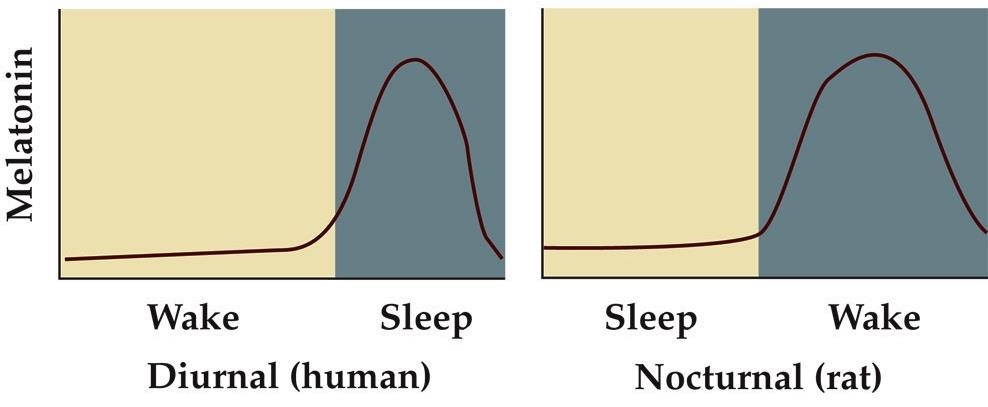
What’s the difference in glucocorticoids between diurnal and nocturnal animals?
strong circadian rhythms of GC secretion in most vertebrates
Regulated by SCN and adrenal biological timekeepers
Persist even when under constant light conditions
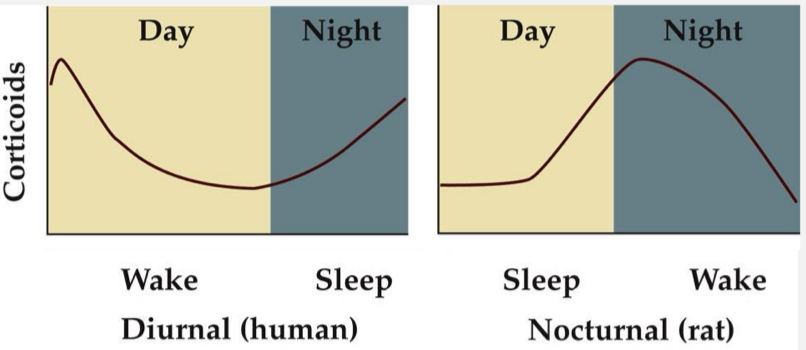
What is advanced sleep-phase syndrome? (ASPS)
circadian clock runs fast (“advanced”)
unable to stay awake until their desired bedtime
Unable to stay asleep until their desired waketime
Rare disorder, inherited
Mutation in the per gene?
per gene produces PER protein on a 24 hr cycle
Per genes necessary for entrainment to light cues
Treatment: light therapy
Describe blind people and circadian rhythms.
Most totally blind people have circadian rhythm abnormalities; free-running delayed
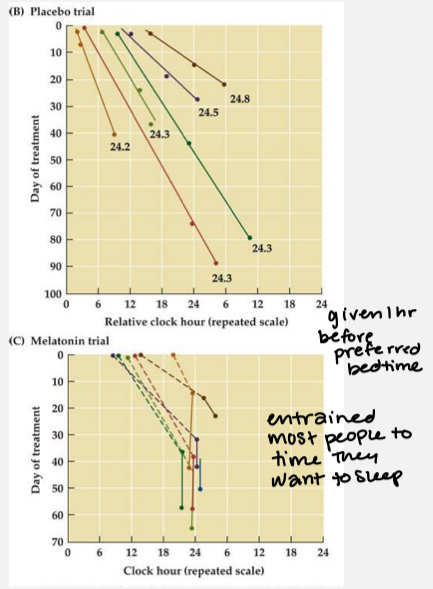
What is shift worker syndrome?
Results from external conditions
Even permanent night workers get 2 hours less sleep than day workers
Fatigue, poor performance, indigestion, GI problems, depression, diabetes, cancer
Treatment: bright lights during work, block light during sleep
What’s the relationship between circannual and seasonal rhythms?
adjusts the physiology and behavior of an organism to the changing conditions of the world
A functional circadian clock is required to make seasonal adjustments in behavior
The SCN serves as both a clock and a calendar due to response in photoperiod
How is melatonin released in response to photoperiods?
Photoperiod (day length) can be measured by the duration of melatonin secretion
When a threshold of melatonin is reached (i.e. during “short-day” conditions) a short-day response occurs (such as testes regression)
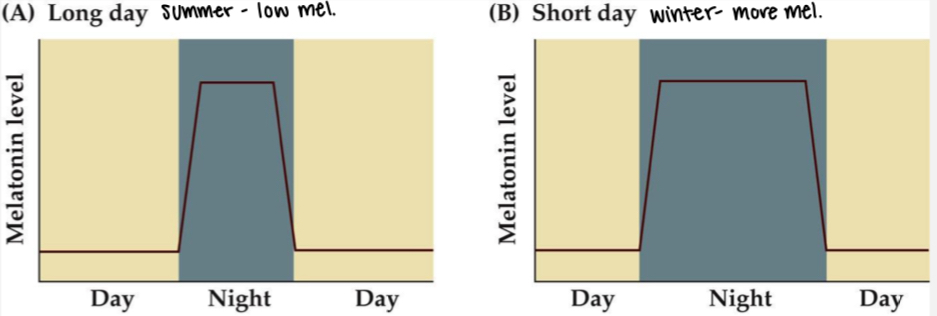
What are proximate factors?
Animals commonly synchronize reproduction with the seasons via neuroendocrine processing of photoperiod cues
In mammals, melatonin concentration helps signal photoperiod
secreted at night, inversely proportional to day length
Summer: long days, short nights, mean less melatonin across the night
This pattern of melatonin secretion activates GnRH in some seasonal to trigger reproduction as spring and summer approaches
Latitude is a positive predictor of more seasonal rhythms (higher latitude, more seasonal the rhythms)
Seasonal rhythms serve to
maximize food, successful reproduction, minimize mortality
What’s the relationship between serotonin and melatonin?
Serotonin is maximal during daylight hours and drops after the onset of darkness as the pineal gland converts most serotonin to melatonin
As daylight hours wane (winter), we get less serotonin in our system
Serotonin makes you feel more focused, emotionally stable, happier, and calmer. Low levels of serotonin are associated with depression
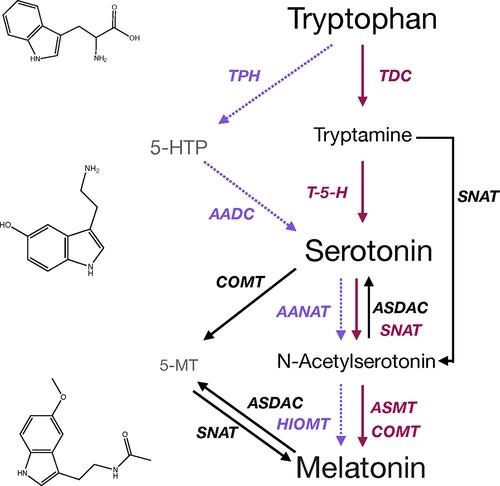
What is seasonal affective disorder?
depression, lethargy, loss of libido, anxiety, inability to concentrate, hyperphagia (excessive eating), hypersomina, carbohydrate cravings whose onset is only during late autumn or winter
northern hemisphere: onset is oct-dec
Southern hemisphere: onset is apr-jun
Disappears entirely with onset of summer (sometimes causes a swing to mania)
Higher incidents at higher latitudes, more likely for long night, short day
Women affected more than men
How do you treat seasonal affective disorder?
Phase-advance your biological rhythms in winter
Light-therapy can help with this
light treatment in morning can realign inappropriately entrained circadian rhythms
Need 1500 lux or greater
Spend time outdoors, regular exercise
Eat less processed foods and more fruits and vegetables
Antidepressant medications (SSRIs) for severe cases
